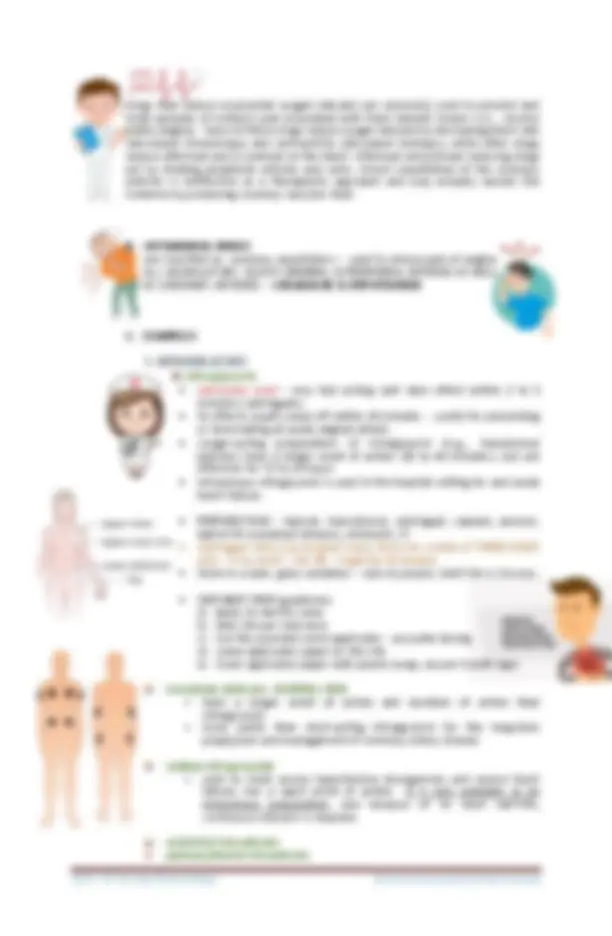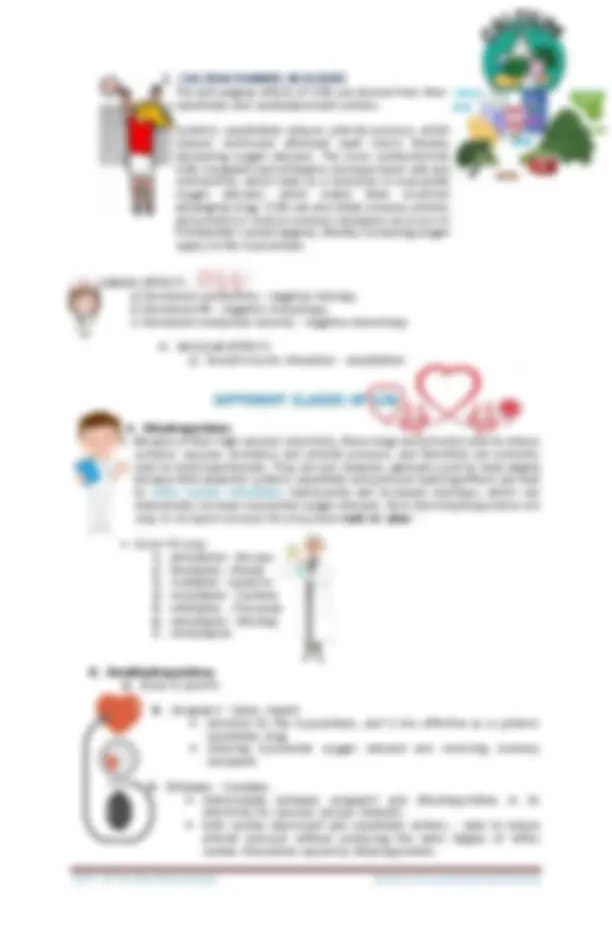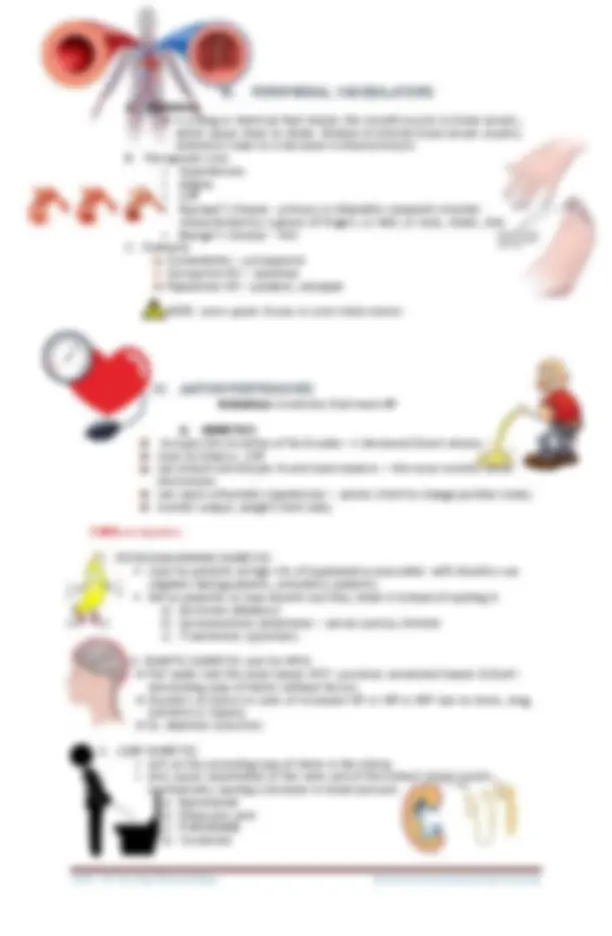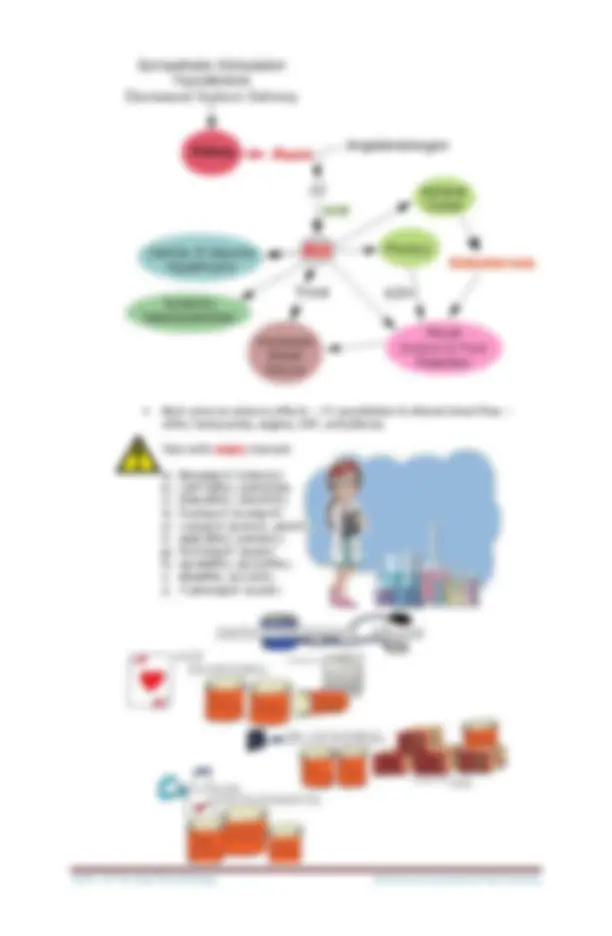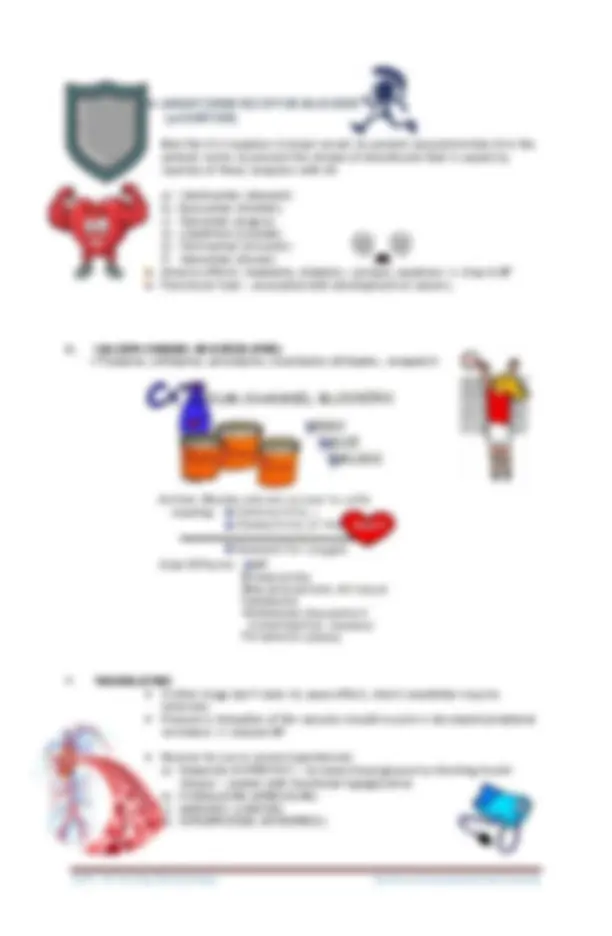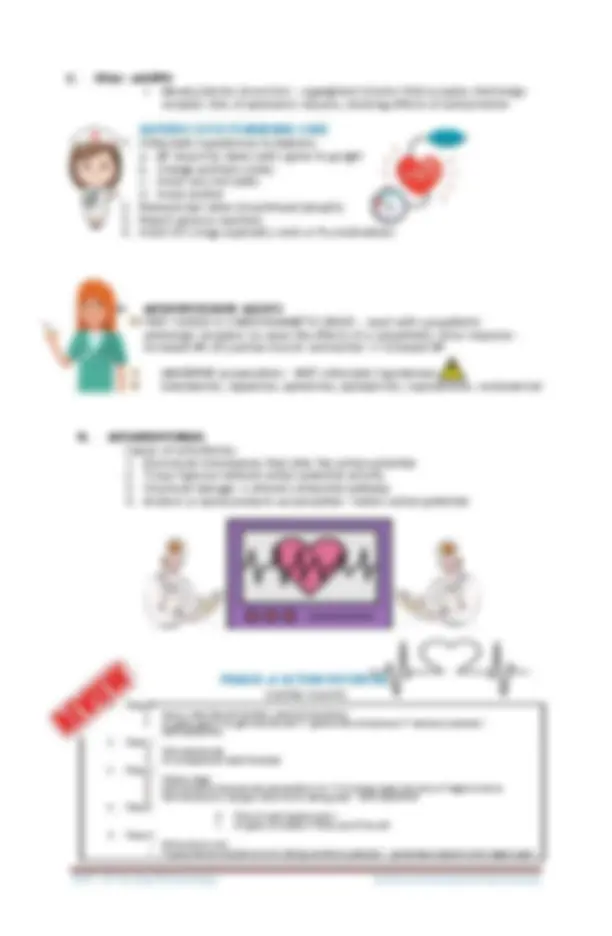Download MODULE 3.3 - CARDIO. and more Lecture notes Pharmacology in PDF only on Docsity!
Lesson 3
CARDIOVASCULAR DRUGS
I. CARDIOTONIC DRUGS
A. USES
For Congestive Heart Failure & cardiac arrhythmia (atrial fibrillation or flutter) B. ACTION inhibit the membrane bound Na+-K+-ATPase pump responsible for Na+-K+ exchange which will result to more Ca intracellularly (review Sliding Filament Theory) improved myocardial contraction increased blood flow to organs including kidney (better diuresis—better urine output) They have an antiarrhythmic effect by prolonging the refractory period of the AV node , reducing the number of impulses reaching the ventricles. Cardiac output is restored but atrial fibrillation or atrial flutter are not abolished. C. EXAMPLES
- Digoxin ( lanoxin ) – Onset 15-30mins; Peak 1.5-5 hours ; Half life(HL): – 36 h
- Digitoxin – Onset 25 – 120 M; Peak 4-12 h; HL – 4 - 6 D
- Acetyldigoxin
- Lanatoside C
- G-strophanthin D. ADMINISTRATION Digitalizing dose – IV or PO – quickly raise the serum drug level to therapeutic level Maintenance dose is 0.125 to 0.5 mg PO daily E. GUIDELINES FOR ADMINISTRATION
a) Slows (negative - chronotrpic) but strengthens (positive + inotropic) heart
b) Loading dose higher than maintenance dose c) ECG should be done before digitalizing d) Withhold if apical pulse is <60 ,> 90 or 100; <90-110 for child. e) IV digoxin is given in ICU – not much in other units; may be given by a doctor f) Assess for digitalis toxicity F. DIGITALIS TOXICITY (above 2.0 ng/mL)
- Causes: a) Overdose b) Drug interaction – quinidine, verapamil, amiodarone c) Diuretics – cause K loss increased risk d) Hypomagnesemia - needed for the adequate function of the Na+/K+-ATPase pumps in the cells of the heart; inhibits release of potassium, a lack of magnesium increases loss of potassium. Intracellular levels of potassium decrease and the cells depolarise. Digoxin increases this effect. Both digoxin and hypoMg inhibit the Na-K-pump resulting in decreased intracellular potassium e) Decreased kidney function
- Symptoms: a) Visual changes Halos or rings around objects Seeing lights or bright spots Changes in color perception Blind spots in vision Blurred vision b) Confusion c) LOA d) N/V, diarrhea e) Palpitations f) Irregular pulse g) Decreased urine output overall swelling orthopnea
- Tests a) Blood chem. – K & Mg level b) BUN, creatinine – kidney function
- Treatment – depends on the cause Activated charcoal Lavage DIGIBIND – antidote for life threatening intoxication NOTE: don’t adjust dose to obese because fats don’t absorb the drug Base dose on ideal body weight II. ANTIANGINAL DRUGS A. How do antianginal drugs affect myocardial oxygen supply and demand, and how do these actions reduce chest pain? Angina results from a reduction in the oxygen supply/demand ratio. Therefore, in order to alleviate the pain, it is necessary to improve this ratio. This can be done either by increasing blood flow (which increases oxygen delivery or supply), or by decreasing oxygen demand (i.e., by decreasing myocardial oxygen consumption).
Pharmacologic interventions that block coronary
vasospasm (coronary vasodilators) or inhibit clot
formation are used to treat variant and unstable
angina, respectively. These drugs act by
increasing coronary blood flow and oxygen
supply, or by preventing vasospasm and clot
formation, and associated decreases in blood
flow. Drugs that reduce myocardial oxygen
demand are also given to patients with these two
forms of angina to reduce oxygen demand and
thereby help to alleviate the pain.
2. CALCIUM CHANNEL BLOCKERS
The anti-anginal effects of CCBs are derived from their vasodilator and cardiodepressant actions. Systemic vasodilation reduces arterial pressure, which reduces ventricular afterload (wall stress) thereby decreasing oxygen demand. The more cardioselective CCBs (verapamil and diltiazem) decrease heart rate and contractility, which leads to a reduction in myocardial oxygen demand, which makes them excellent antianginal drugs. CCBs can also dilate coronary arteries and prevent or reverse coronary vasospasm (as occurs in Printzmetal's variant angina), thereby increasing oxygen supply to the myocardium. CARDIAC EFFECTS a) Decreased contractility – negative inotropy b) Decreased HR – negative chronotropy c) Decreased conduction velocity – negative dromotropy VASCULAR EFFECTS a) Smooth muscle relaxation – vasodilation
DIFFERENT CLASSES OF CCB
A. Dihydropyridines Because of their high vascular selectivity, these drugs are primarily used to reduce systemic vascular resistance and arterial pressure, and therefore are primarily used to treat hypertension. They are not, however, generally used to treat angina because their powerful systemic vasodilator and pressure lowering effects can lead to reflex cardiac stimulation (tachycardia and increased inotropy), which can dramatically increase myocardial oxygen demand. Note that dihydropyridines are easy to recognize because the drug name ends in "pine." Given PO only:
1. amlodipine - Norvasc 2. felodipine - Plendil 3. isradipine - DynaCirc 4. nicardipine - Cardene 5. nifedipine - Procardia 6. nimodipine - Nimotop 7. nitrendipine B. Nondihydropyridines Given IV and PO 8. Verapamil – Calan, Isoptin selective for the myocardium, and is less effective as a systemic vasodilator drug reducing myocardial oxygen demand and reversing coronary vasospasm 9. Diltiazem – Cardizem intermediate between verapamil and dihydropyridines in its selectivity for vascular calcium channels. both cardiac depressant and vasodilator actions, - able to reduce arterial pressure without producing the same degree of reflex cardiac stimulation caused by dihydropyridines.
III. PERIPHERAL VASODILATORS
A. Definition is a drug or chemical that relaxes the smooth muscle in blood vessels, which causes them to dilate. Dilation of arterial blood vessels (mainly arterioles) leads to a decrease in blood pressure. B. Therapeutic Uses Hypertension Angina CHF Raynaud’s disease – primary or idiopathic vasopastic disorder characterized by cyanosis of fingers, or feet, or nose, cheek, chin Buerger’s disease - TAO C. Examples Cyclandelate - cyclospasmol Isoxsuprine HCl - vasodilan Papaverine HCl – pavabid, vasospam NOTE: some spasm & vaso in some trade names
IV. ANTIHYPERTENSIVES
Definition: medicines that lower BP A. DIURETICS Increase the excretion of Na & water decreased blood volume Used for Edema , CHF can disturb electrolytes & acid-base balance – --the nurse monitor serum electrolytes can cause orthostatic hypotension – - advice client to change position slowly monitor output, weight client daily TYPES of diuretics
- POTASSIUM-SPARING DIURETICS Used for patients at high risk of hypokalemia associated with diuretics use (digitalis-taking patients, arrhythmic patients) Not as powerful as loop diuretic but they retain K instead of wasting it a) Amiloride (Midamor) b) Spironolactone (aldactone) – can be used by children c) Triamterene (dyrenium)
- OSMOTIC DIURETICS (not for HPN) Pull water into the renal tubule (PCT- proximal convoluted tubule & DLoH – descending Loop of Henle) without Na loss Diuretics of choice in cases of increased ICP or IOP or ARF due to shock, drug overdose or trauma Ex. Mannitol (Osmitrol)
- LOOP DIURETICS acts on the ascending loop of Henle in the kidney also causes vasodilation of the veins and of the kidney's blood vessels, mechanically causing a decrease in blood pressure. a) Bumetanide b) Ethacrynic acid c) FUROSEMIDE d) Torsemide
2. ALPHA-BETA ADRENERGIC BLOCKERS
Block all adrenergic receptor NE is blocked no sympathetic stress reaction lower BP, PR, increased renal perfusion with decreased renin levels a) Carvedilol (coreg) b) Guanadrel (hylorel) c) Guanethidine (ismelin) d) Labetalol (trandate)
- ALPHA-adrenergic blockers Some blockers have a specific affinity for alpha-receptor sites limited use only PHENTOLAMINE (regitine) – only the one in use today Useful in diagnosing pheochromocytoma
- ALPHA 1 – selective adrenergic blocker
(ZOSIN)
Have a specific affinity for alpha 1 receptors Block the post-synaptic alpha 1 receptor sites decreased in vascular tone & vasodilation fall in BP a) Alfuzosin (uroxatral) b) Doxazosin (cardura) c) PRAZOSIN (minipress) d) Tamsulosin (flomax) e) TERAZOSIN (hytrin)
- ALPHA 2 - AGONISTS Stimulates alpha2-adrenoceptors in the brain stem, thus activating an inhibitory neuron, resulting in reduced sympathetic outflow from the CNS, producing a decrease in peripheral resistance, renal vascular resistance, HR, and BP a) Clonidine (catapress) b) Guanfacine c) Methyldopa
C. ACE INHIBITORS (acePRIL)
Blocks the conversion of AI to AII in the lungs The RAAS plays an important role in regulating blood volume and systemic vascular resistance, which together influence cardiac output and arterial pressure. Renin is a proteolytic enzyme that is released into the circulation primarily by kidneys. Its release is stimulated by
- sympathetic nerve activation
- renal artery hypotension (caused by systemic hypotension or renal artery stenosis)
- decreased sodium delivery to the distal tubules of the kidney.
Most common adverse effects : r/t vasodilation & altered blood flow – - reflex tachycardia, angina, CHF, arrhythmias Take with empty stomach a) Benazepril (lotensin) b) CAPTOPRIL (CAPOTEN) c) ENALAPRIL (VASOTEC) d) Fosinopril (monopril) e) Lisinopril (prinivil, zestril) f) MOEXIPRIL (UNIVASC) g) Perindopril (aceon) h) QUINAPRIL (ACCUPRIL) i) RAMIPRIL (ALTACE) j) Trandolapril (mavik)
G. Other antiHPN Mecamylamine (Inversine) – a ganglionic blocker that occupies cholinergic receptor sites of autonomic neurons, blocking effects of acetylcholine
ADVERSE EFFECTS/NURSING CARE
- Orthostatic hypotension & dizziness a. BP should be taken both supine & upright b. Change positions slowly c. Avoid very hot baths d. Avoid alcohol
- Rebound hpn when discontinued abruptly
- Report adverse reactions
- Avoid OTC drugs especially colds or flu medications V. ANTIHYPOTENSIVE AGENTS FIRST CHOICE IS SYMPATHOMIMETIC DRUGS – react with sympathetic adrenergic receptors to cause the effects of a sympathetic stress response : increased BP, BV,cardiac muscle contraction increased BP MIDODRINE (proamatine) – WOF orthostatic hypotension Dobutamine, dopamine, ephedrine, epinephrine, isoproterenol, metaraminol VI. ANTIARRHYTHMIAS Causes of arrhythmias:
- Electrolyte disturbances that alter the action potential
- Tissue hypoxiaaltered action potential activity
- Structural damage altered conduction pathway
- Acidosis or waste products accumulation alters action potential
PHASES of ACTION POTENTIAL
(cardiac muscle)
- Phase 0 Occurs when the cell reaches a point of stimulation Na gates open Na gets into the cell positive flow of electrons electrical potential - DEPOLARIZATION
- Phase 1 Short period only Na ion equalizes inside & outside
- Phase 2 Plateau stage Cell membrane becomes less permeable to Na Ca slowly enters the cell as K begins to leave Cell membrane is trying to return to its resting state - REPOLARIZATION
- Phase 3 H. Time of rapid repolarization I. Na gates are closed; K flows out of the cell
- Phase 4 Cell comes to rest K-pump returns membrane to its resting membrane potential – spontaneous depolarization begins again
VII. ANTIARRYTHMIC DRUGS
Affect the action potential of cardiac cells, altering their automaticity, conductivity, or both – can also produce new arrhythmias (proarrythmic) TYPES
- CLASS 1 block the Na channels during action potentials Local anesthetics or membrane-stabilizing agents Stabilize the membrane by binding to Na channels Preferable in tachycardia a) Class Ia – depress phase 0 & prolong the duration of action potential
- Disopyramide (NORPACE)
- Moricizine (ethmocine)
- PROCAINAMIDE (pronestyl)
- QUINIDINE (QUINAGLUTE) b) Class Ib – depress phase 0 somewhat & actually shorten the duration of AP
- LIDOCAINE (XYLOCAINE) – most frequently used
- Mexiletine (mexitil) c) Class Ic – markedly depress phase 0, with a result and slowing of conduction
- Have little effect on the duration of AP
- Flecainide (tambocor)
- Propafenone (rythmol)
- CLASS 2 Are beta-adrenergic blockers that block beta receptors causing a depression of phase 4 of the AP slow the recovery of the cells slowed conduction & decreased automaticity a) Acebutolol (spectral) b) Esmolol (BREVIBLOC) c) Propranolol (INDERAL)
- CLASS 3 Block K channels, prolonging phase III of the AP, which prolongs repolarization & slows the rate of conduction of the heart All of these are proarrythmic a) Amiodarone (cordarone) b) Bretylium (genric) c) Dofetilide (tikosyn) d) Ibutilide (corvert) e) Sotalol (betapace)
- CLASS 4 Block Ca channel in the cell membrane depression of depolarization & prolongation of phase 1 & 2 of repolarization slows automaticity & conduction CCB – diltiazem (cardizem); verapamil (calan)
- Other antiarrythmic drugs a) Adenosine (ADENOCARD) Used to convert supraventricular tachycardia (DOC) to sinus rhythm if vagal maneuvers have been ineffective Slows conduction through AV node Decreases automaticity in AV node b) Digoxin Also used at times Slows calcium from leaving the cell, prolonging action potential, & slowing conduction

